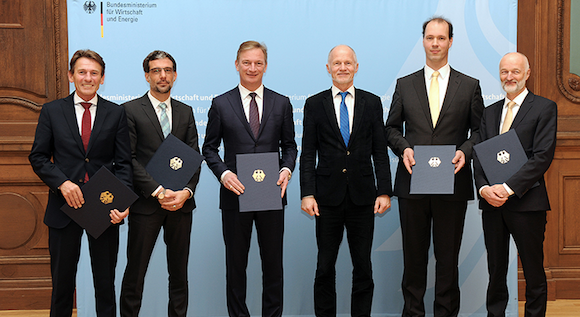Showcases demonstrating the future of the energy transition
Five model regions are testing technologies for our future energy system. The Federal Ministry for Economic Affairs and Energy is providing more than 200 million euros for this work, in which more than 200 companies are involved.
 State Secretary in the Federal Ministry for Economic Affairs and Energy Rainer Baake (3rd from right) with representatives of the five model regions. © BMWi/Susanne Eriksson
State Secretary in the Federal Ministry for Economic Affairs and Energy Rainer Baake (3rd from right) with representatives of the five model regions. © BMWi/Susanne Eriksson
Today, Mr Rainer Baake, State Secretary in the Federal Ministry for Economic Affairs and Energy, handed over the formal notices approving funding for five model regions, which are to serve as a testing ground for our energy supply of the future. All of these regions are involved in the programme "Smart Energy Showcases - Digital Agenda for the Energy Transition" (SINTEG). “We are approaching the point where renewables will dominate our electricity supply, sometimes even providing 100 per cent of our electricity”, said Mr Baake. The SINTEG programme is to provide answers as to how we can organise our energy supply in a way that makes it climate-friendly, secure, and efficient. Mr Baake explained: “The programme is about developing solutions and demonstrating their viability in real life.”
More than 200 million euros over four years
Over the next four years, the Federal Ministry for Economic Affairs and Energy will be providing a total of more than 200 million euros for SINTEG, across its five model regions. SINTEG is part of the Federal Government’s Digital Agenda . In addition to the public funds being injected into the programme, there will also be private investments, which will bring the grand total to more than 500 million euros of investment into the digitisation of the energy sector. More than 200 companies and other stakeholders, including scientific institutions, are involved in SINTEG.
Model regions in all parts of Germany
The model regions were chosen by means of a competition. The regions that have been selected stretch across 15 of the 16 German states. Now that the approval notices have been handed over, implementation of the programme can begin. These are the showcases that have been selected:
- “C/sells: Large-scale showcase in the ‘solar arch’ in southern Germany: This showcase spans the states of Baden-Württemberg, Bavaria and Hesse, and focuses on solar energy. The goal is to optimise the way in which energy is generated and consumed at regional level.
- ‘Designnetz: a modular concept for the energy transition – from isolated solutions to an efficient energy system of the future’: The ‘Designnetz’ showcase spans North Rhine-Westphalia, Rhineland-Palatinate and the Saarland. It aims to supply solar and wind energy to urban and industrial consumers.
- ‘enera: the next big step in the energy transition’: The ‘enera’ showcase is located in Lower Saxony and concentrates on regional ancillary services that stabilise the local grid and further improve the reliability of our electricity supply based on renewables.
- ‘NEW 4.0: the energy transition in the north of Germany‘: The ‘NEW 4.0’ showcase spans Schleswig-Holstein and Hamburg. It is to demonstrate that 70 per cent of the region’s energy could be generated from renewable sources in a way that is both secure and efficient, and that this could be achieved as early as 2025.
- ‘WindNODE: showcase for smart energy from the north-east of Germany’: This showcase spans the five states that used to be East Germany, and Berlin. Its goal is to integrate renewable energy sources in the electricity, heat and mobility sectors, and to do this efficiently.

